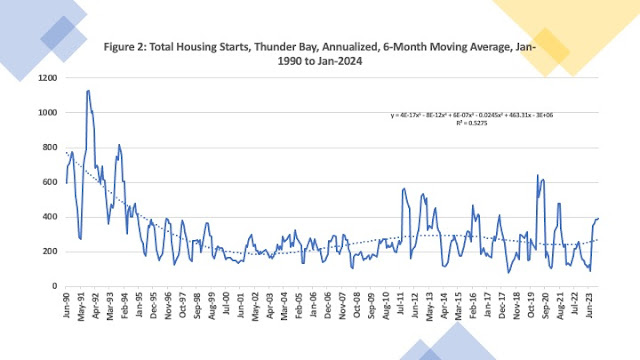The City of Thunder Bay is engaged in budget season and striving to keep its total tax levy increase to 2.6 percent. As part of its new two-part budgeting approach, the capital budget two-year plan is now underway with initiatives including $34 million in road improvements in 2026 with another $26 million in 2027 as well as initiatives in waste diversion and transit. The proposed capital budget for 2026 amounts to $160 million while 2027 is going to be lower at $148 million. January will see the operating budget and with the 2025 total levy at $241.7 million, a 2.6 percent increase could bring the levy up to $248 million.
The proposed 2026 tax levy increase is indeed modest by recent historical standards as the accompanying figure shows as the 2025 increase was 5.2 percent and 2025 was 4.5. However, the proposed 2.6 increase is also below the average increase over the 2015 to 2025 period which comes in at 3.4 percent. Of course, increases need to be balanced against what the needs are and keeping rates low for their own sake is not necessarily the ultimate policy objective. Rather, the aim should be to provide the best public services desired at the lowest costs possible which implies efficient and not wasteful spending, which brings me to the main event.
Whether the City of Thunder Bay will come in with a tax levy increase of 2.6 percent or not remains to be seen. However, what is more important is what often seems to be a lack of strategic direction with how Thunder Bay seems to allocate its spending and projects by doing them in a manner that often works at cross purposes. A case in point is the recent moves to build density housing in the City of Thunder Bay to address the housing shortage and provide affordable housing.
The City of Thunder Bay is preparing to sell municipally owned land to developers to build density housing. The pieces of land are: 300 Tokio Street, 144 Fanshaw Street, 791 Arundel Street, and the land between 211-223 Tupper Street and 224 Camelot Street. Despite the oft stated claim to want to provide affordable housing, the City has apparently rejected a developer’s affordable housing bid for the land that included transitional housing because it was not dense enough. The City of Thunder Bay wishes for: 400 units on Tokio Street, 200 on Fanshaw Street, 600 on Arundel Street, and 185 on Tupper/Camelot streets for a total of about 1,385 units.
Now, Thunder Bay municipal politicians are very good at using the right words and as one councillor was quoted:
<<"There is no question that we are in a housing crisis, not only in the city of Thunder Bay, across the province and across the nation," Foulds said. "We're also in a climate crisis."
"In order to deal with those two huge issues, we do need to have a focus on intensification and increasing the density of our cities, building on existing infrastructure. With that said, we do need to make sure that the infrastructure can handle it. We also must make sure that the developments are appropriate and safe.">>
The problem here is that Thunder Bay’s idea of increasing density in a climate crisis apparently includes cutting down swaths of green space to build density development in areas often removed from where density either already exists or should be promoted. Moreover, the constant dispersion of new development results in the new residents of these “density developments” having to rely mainly on automobile transport rather than public transit which is not convenient or timely given the dispersed nature of the city.
As noted in an earlier post:
<<Of these four proposed locations, three are essentially going to be plonked on available space – often green space – in the midst or immediately adjacent to existing residential areas. Only one – the Camelot Street location is going to be placed near a downtown core area. And that is the point. To date, the large builds on Junot and Fulton have been built in or adjacent to existing lower density residential areas and often at the expense of nearby green space. Except for Camelot – which is a good location if one is planning to build up core area density – these are all scattered willy-nilly in places where the only option is to drive somewhere to get anything done.>>
As noted in the same post, the logical place to target density developments in Thunder Bay should be the two former downtown cores areas of Port Arthur and Fort William and the corridor connecting them that runs along and immediately adjacent to Water/Fort William Road/Simpson Streets and Algoma/Memorial/May Streets.
So, how does this come back to my point about wasteful spending? Thunder Bay is constantly trying to revitalize its core areas – the former cores of Port Arthur and Fort William - with initiatives that cost millions of taxpayer dollars. For example, the recently completed north core/Port Arthur streetscape project clocked in at about $13 million. Currently underway is the south core/Fort William Victoria Avenue revitalization project which is going to kick in at $18.4 million. Then there is the Simpson Street redevelopment cost from the end of Victoria Avenue to the Ogden/Dease Street area which is approaching the $8-$9-million-dollar cost.
In total, this is almost $40 million dollars in capital spending and rather than being additionally leveraged into a denser set of core urban areas with the tens of millions of dollars in federal housing infrastructure money, it is going to be left to mainly its own devices to attract residents. And beyond these four proposed projects, there is the proposed Central Avenue Development Lands project which while ostensibly in the “center” of the city will build over 40 acres of largely wooded area eliminating much of the green corridor that runs from Lakehead University through to the College and ultimately Chapples Park.
Thunder Bay’s development motto is essentially “density if necessary but not necessarily urban density.” Thunder Bay equates urban density as simply the act of putting multi-residential units on anywhere the city has surplus land rather than working with owners in existing brownfield areas to consolidate derelict and underused properties. Infill is not always the same as creating urban density. Thunder Bay wastes taxpayer money by providing business owners in the former core areas with beautification baubles but then does not follow up with real strategic investment in those areas. It is the type of short-term thinking that has led to the creation of a dispersed and costly to service city with an over-reliance on automobiles. Enjoy the short-term construction benefits from all the new housing projects as the future costs to both the taxpayer in servicing costs and the environment will be substantial.

















